Last updated on March 26th, 2024 at 11:25 am
A single-phase induction motor is a type of AC motor that consists of a single-phase winding on the stator and requires a single-phase AC supply to create a working flux for the motor.
But have you ever thought, why do we need a single-phase induction motor when we already have a three-phase induction motor?
It is because our houses and offices are supplied with single-phase AC power. The load requirements are also too small to use a three-phase induction motor. So, using a single-phase induction motor is economical as compared to a three-phase induction motor.
But, now the question arises, how is a single-phase and a three-phase induction motor related? Are they somehow similar or entirely different? Why is a single-phase motor not self-starting, and how a double-revolving field theory explains it?
These are only a few questions out of many that may have come to your mind. To get complete information on single-phase induction motors, keep on reading this article till the end.
Table of Contents
Construction of a single-phase induction motor
The construction of a single-phase induction motor is similar to a three-phase squirrel cage induction motor. Just like a three-phase induction motor, it also contains a Stator and Rotor.
Stator of a single-phase induction motor
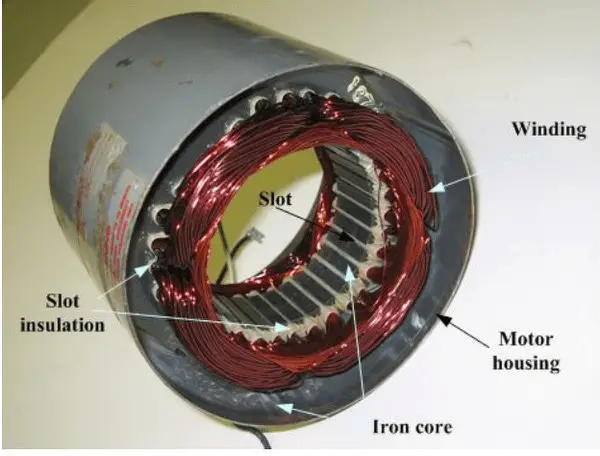
**Image courtesy: Electronic clinic
The stator core is built up of laminated steel to reduce the eddy current and hysteresis loss. The structure is slotted from the inner side and carries the stator winding. But instead of a three-phase winding, only two winding sets are distributed on the stator, viz, a primary winding and an auxiliary winding.
Rotor of a single phase induction motor
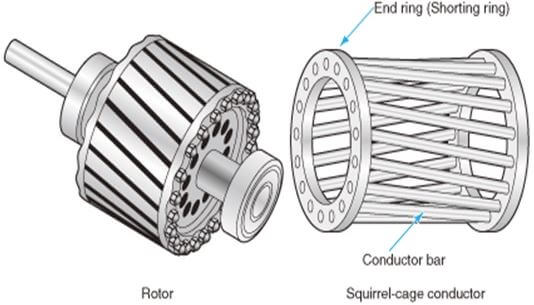
**Image courtesy: PnPn Transistor
The rotor used in the single-phase induction motor is the squirrel cage type. The rotor bars are not parallel to the shaft but skewed by an angle. The skewing prevents the magnetic locking of stator and rotor teeth and provides a uniform running torque.
But despite its low power consumption and other advantages, this motor is not self-starting.
Why is a single-phase induction motor not self-starting?
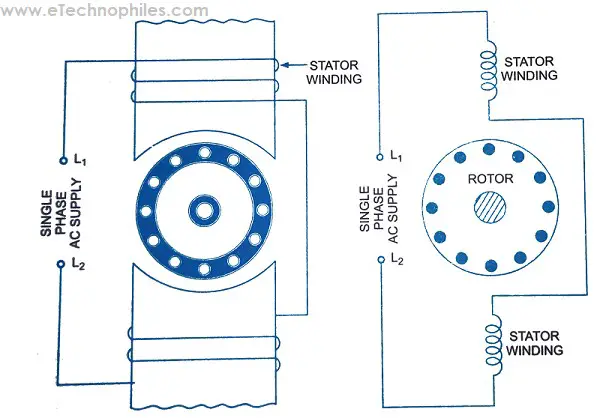
Consider a two-pole stator connected to a single-phase AC source. On exiting the winding with AC supply, a magnetic field develops, whose axis is always along the axis of stator coils. The mmf wave is stationary in space but has a pulsating magnitude.
Due to the mutual induction principle, a current gets induced in the rotor conductors. The currents in the rotor conductors create a magnetic field to oppose the stator’s magnetic field (according to the Lenz law).
Thus, the axis of rotor MMF coincides with the stator MMF, and hence no torque develops at starting. If somehow the resting inertia of the rotor breaks (a push by hand or another means), the motor will pick up speed and continue to rotate in that direction.
So, this motor is not self-starting and requires some external starting methods.
The concept behind the non-self-starting of single phase induction motor
The following two theories give a detailed insight into the non-self-starting behavior of single-phase induction motors.
- Double revolving field theory
- Cross-field theory
Both theories explain the same concept by a different approach. To understand the concept clearly, let us discuss the double field revolving theory.
Double revolving field theory
- Let us assume that the stator magnetic field produces a pulsating magnetic field with a maximum amplitude of Qm.
- So, according to this theory, we can resolve the stator flux into two components, each having half the value of the maximum magnitude of stator flux, i.e., Qm/2.
- Both the fluxes rotate inside the stator periphery with a synchronous speed Ns but in opposite directions.
- Let Qf be the stator flux rotating in the anticlockwise direction. Assume this as the forward direction of flux rotation. Then Qb will be the backward component of stator flux rotating in the clockwise direction.
- So, at starting, the effect of both flux cancels each other (as they are equal and opposite). Hence there is no resultant flux. The figure below shows the initial position of both vectors.
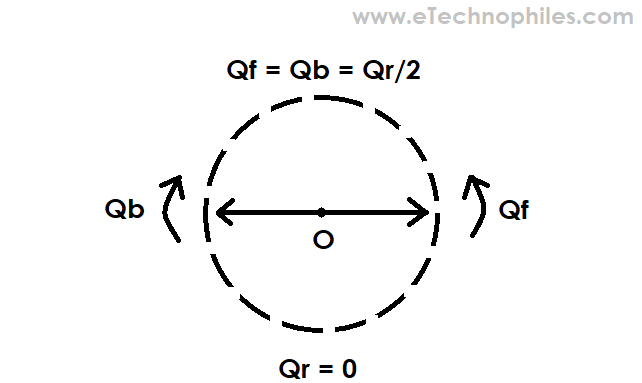
- After a 90-degree rotation, both vectors point in the direction as shown in the figure. At this point, both components of the magnetic field add up to give a resultant magnetic field Qm.
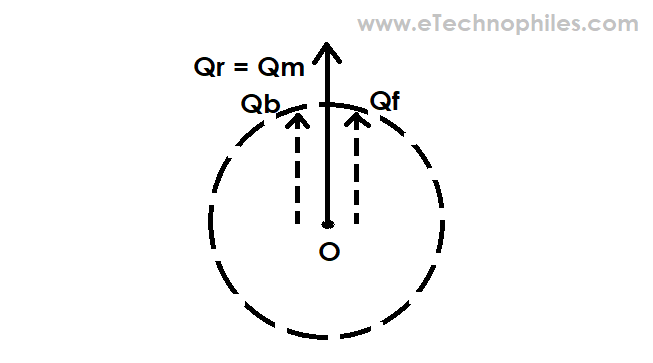
- After another 90-degree rotation, the two vectors again face in opposite directions, hence nullifying the effect of each other.
- If we plot the overall stator magnetic field, we obtain a sinusoidal wave, as shown in the figure.

It shows that the stator magnetic field has an alternating but pulsating nature.
Interaction of the stator flux with the rotor flux
- Each component of the stator flux induces a current in the rotor (according to Faraday’s law of electromagnetic induction). The rotor current produces rotor flux, and the interaction of stator and rotor flux creates torque.
- Let the rotor flux that interacts with Qf create a torque in an anticlockwise direction, while the rotor flux that interacts with Qb creates a torque in a clockwise direction.
- So, these two torques try to rotate the rotor in the opposite direction. But, having the same magnitude, the rotor is unable to move. If somehow the torque on one side becomes more, the rotor will keep rotating in that particular direction.
Why are three-phase induction motors self-starting?
In the case of a three-phase induction motor, a three-phase source supplies power to it. The interaction of three time-varying currents fed to a three-phase distributed winding creates a rotating magnetic field.
But, in the case of a single-phase induction motor, we only have a single AC source. And from the above explanation, we saw how it is unable to create a rotating magnetic field.
So, if we can produce an additional time-varying flux from the same AC source, our problem gets eliminated. It is because a rotating field requires the interaction of at least two magnetic fields. But how do we make that happen?
Starting methods of Single-phase induction motor
To produce an additional flux from the same source, we connect an extra winding (aka Auxiliary winding) placed perpendicular to the primary winding of the motor. The impedance of the auxiliary winding is different from the primary winding. In this way, when the current flows through both the windings and a phase difference gets created between them. Due to the interaction of flux from these currents, a rotating magnetic field gets created.
This rotating field interacts with the rotor, and this now creates a unidirectional torque for the rotor.
What is phase-splitting?
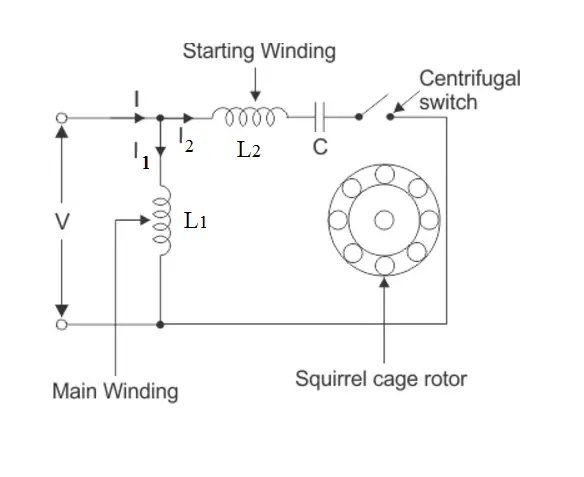
**Image courtesy: electronics StackExchange
The process of adding an auxiliary winding with a suitable impedance perpendicular to the primary winding is known as phase-splitting. The induction motors that employ the phase-splitting principle are known as phase-split motors. So, the split-phase motors are of the following types.
- Resistance start motor
- Capacitor start motor
- Capacitor start capacitor run motor
- Permanent capacitor motor
- Shaded pole motor
Although the torque generated by this motor is not as strong as a three-phase induction motor. But, it is still enough to power the household loads, such as vacuum cleaners, fans, pumps, blowers, drill machines, etc.
Comparison between a three-phase and a single-phase induction motor
So, after learning about both induction motors, let us quickly summarise their crucial points with the help of the following table.
| Three-phase induction motor | Single-phase induction motor |
| A three-phase source supplies power to the motor. | Only a single-phase source supplies power to the motor. |
| It is a self-starting motor. | It is not a self-starting motor. |
| The starting torque is more. | The starting torque is less as compared to a three-phase induction motor. |
| Their construction is complex and these motors are difficult to repair. | Their construction is simple and they are easy to repair. |
| The size of a three-phase induction motor is more than a single-phase induction motor for the same power rating. | The size of a single-phase induction motor is less than a three-phase induction motor for the same power rating. |
| Its power factor is high. | Its power factor is low. |
| It is quite expensive. | It is cheaper. |
| Its efficiency is higher as compared to a single-phase motor. | Its efficiency is low. |
